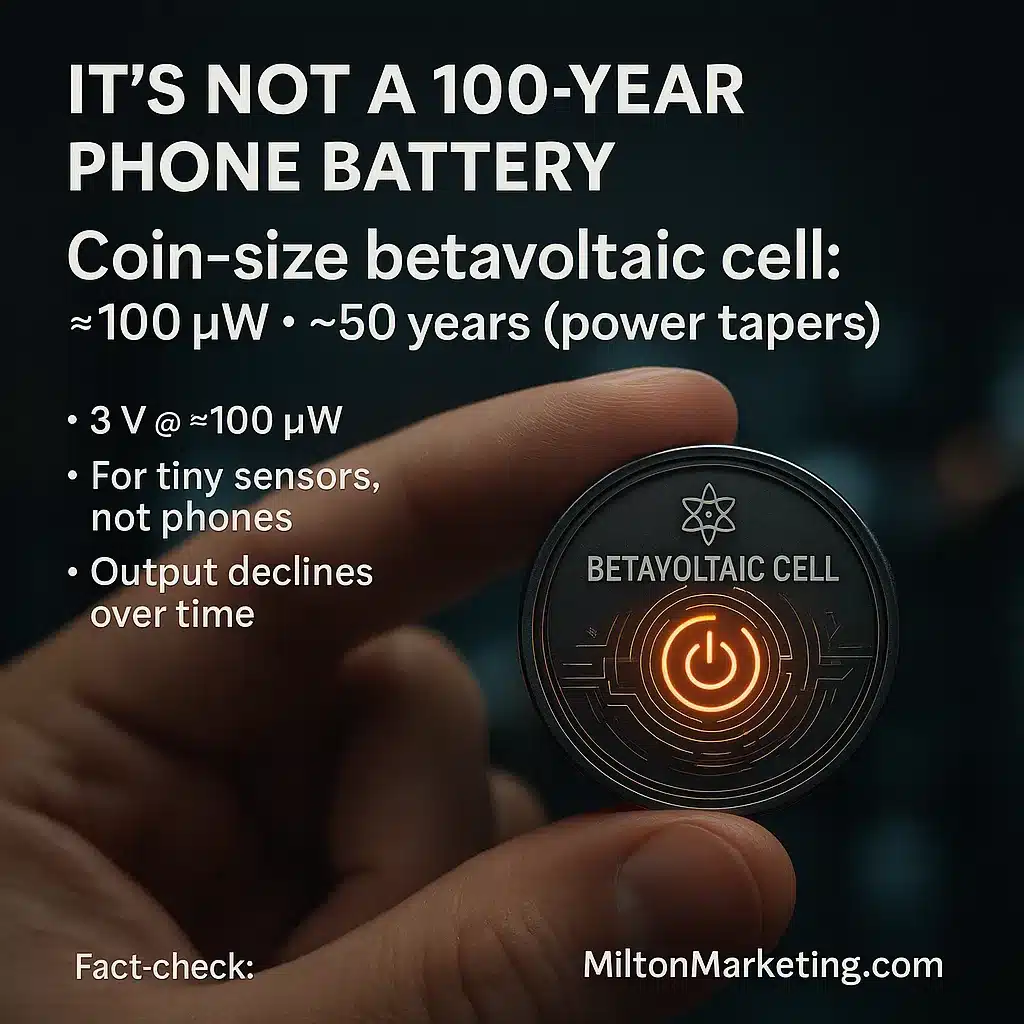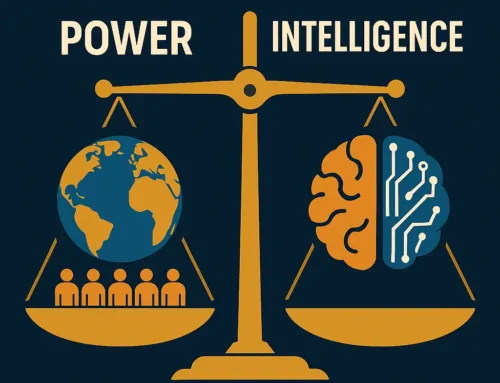
Approx. read time: 10.5 min.
Post: China’s Coin-Size “Nuclear” Betavoltaic Cell, Demystified: Real Specs, Real Limits, and Where It Actually Wins
China’s Coin-Size “Nuclear” Betavoltaic Cell, Demystified: Real Specs, Real Limits, and Where It Actually Wins
Slug: betavolt-ni63-betavoltaic-coin-cell-50-years
Meta description (155 chars): Betavolt’s Ni-63 betavoltaic cell makes ~3 V at ~100 µW for decades (power tapers). Great for tiny sensors—not phones. Safety, math, use cases, FAQs.
Focus keyphrase: Betavolt BV100 betavoltaic battery
🧭 Why this deep-dive?
Hype headlines said “100-year coin battery.” Reality: a Betavolt BV100 betavoltaic battery trickle source that can feed microwatts for decades, with output slowly declining. That’s both impressive and easy to misunderstand. Below, we cut through the noise: what betavoltaics are, what Betavolt (BV100) claims, the power math in plain English, safety, realistic use cases, integration tips, and what to watch next. Where facts matter, we cite reputable sources. Wikipedia+2Live Science+2
⚛️ What a Betavolt BV100 betavoltaic battery cell actually is:
A Betavolt BV100 betavoltaic battery device is a nuclear (radioisotope-based) power source that converts beta particles directly into electricity using a semiconductor junction—think “PV solar cell,” except the “light” is the stream of low-energy electrons from radioactive decay. No charging cycles. No combustion. Just a steady dribble of electrons until the isotope decays enough that the output falls below what your circuit needs. It’s a non-thermal conversion process (unlike RTGs that use radioactive heat with thermoelectrics). Wikipedia+1
🧪 The isotope at the core: Nickel-63 (Ni-63) – Betavolt BV100 betavoltaic battery
Betavolt’s small coin-size module centers on Ni-63, a pure beta emitter with a half-life reported around ~100 years (e.g., ~101 years in classic determinations). That long half-life is the reason decades-long service is plausible—but power declines with time; half-life does not mean “full power for a century.” ScienceDirect+1
Key properties that matter to engineers:
-
Decay type: Beta (electrons), low energy compared to gamma; much easier to encapsulate effectively. Nuclear Regulatory Commission
-
Half-life: ~100–101 years ⇒ activity (and thus power) halves over ~a century. ScienceDirect
🔢 The headline specs you keep seeing—put in context
Multiple outlets summarized Betavolt’s BV100 prototype claims as ~3 V at ~100 µW with a ~50-year service life (power tapering across that span). That is not a phone battery; it’s a micro-generator for ultra-low-power electronics. Live Science+1
Let’s translate the numbers:
-
Power: ~100 µW (microwatts).
-
Voltage: ~3 V.
-
Implied current at 3 V: ~33 µA (because 100 µW ÷ 3 V ≈ 33 µA).
-
Service life framing: “on the order of decades” (~50 years), falling output as Ni-63 decays. Live Science
If you’ve ever designed sleepy sensors, your eyebrow should go up: 33 µA average is usable—but only with ruthless duty-cycling and ultra-low-leak circuitry.
📏 Reality check: How small is 100 µW?
-
A typical smartwatch idle can hover around 1–10 mW (that’s 1,000–10,000 µW), i.e., 10–100× more than BV100’s entire output.
-
A smartphone idle needs far more (milliwatts to hundreds of milliwatts), orders of magnitude beyond reach.
-
A BLE beacon, stripped to the studs with aggressive sleep, can average tens to a few hundred µW depending on interval and TX power—this is the rough neighborhood where a betavoltaic can start to make sense, but only with an energy buffer (tiny rechargeable or supercap) for short bursts.
A quick sanity math: suppose you trickle-charge a 100 mAh thin-film cell from 0 using ~33 µA. Time = 100,000 µAh ÷ 33 µA ≈ 3,030 h, which is about 126 days—four months—to fill, ignoring losses. That’s why calling it a “battery for phones” is fantasy. It’s a micropower generator, not a big tank.
🧲 Betavoltaic vs RTG vs “normal” batteries vs energy harvesting
-
Betavoltaic (BV100-class): direct conversion of beta particles in a junction → tiny, steady output for decades; great in darkness, sealed systems, or places you never want to service. Wikipedia
-
RTG (space probes): converts heat from decay via thermoelectrics → watts to hundreds of watts, but large, hot, and heavily regulated. World Nuclear Association
-
Chemical cells (Li-ion, Li-SOCl₂): store charge; can deliver bursty, high power; capacity depletes and may require replacement or recharge.
-
Energy harvesting (solar/RF/vibration): can exceed 100 µW when resources exist; but are environment-dependent and unreliable in darkness, sealed enclosures, or quiet environments.
Betavoltaics shine where ambient energy is unavailable and maintenance is unacceptable—and you can design your electronics to sip power.
🛡️ Safety snapshot (for non-nuclear people) – Betavolt BV100 betavoltaic battery
-
What leaves the isotope? Beta particles (electrons). Their range in solids is short; thin encapsulation can stop them. Nuclear Regulatory Commission
-
So it’s safe to wear? The design premise is encapsulation that prevents release and exposure; safety depends on package integrity and certification.
-
Who oversees this? Nuclear materials are tightly regulated; in the U.S., the NRC and “Agreement States” handle licensing/oversight. (Regulatory scope varies by country.) Nuclear Regulatory Commission
-
End-of-life: No curbside recycling; licensed take-back is table stakes.
Plain English: treat it like a sealed, specialized part. If the seal is intact and you follow the rules, external dose is engineered to be negligible. If you want to ship thousands internationally, compliance will be your biggest project after the electronics.
🧰 Engineer’s field guide: how to design around ~100 µW
1) Budget like a tyrant.
Make a real average-power budget. Every nanoamp of leakage matters. Target nA–µA sleep currents.
2) Duty-cycle everything.
-
Microcontroller spends >99.9% asleep (deep stop mode).
-
Sensors power-gated; take brief, batched measurements.
-
Radio packets rare and tiny (e.g., advertise once every minutes/hours).
3) Add a tiny buffer.
A thin-film rechargeable or supercapacitor lets you store trickle energy to pay for short bursts (sensor read or radio TX). Size it so your burst never drains below the BV100’s sustainable trickle.
4) Power path discipline.
-
Avoid leaky LDOs; choose ultra-low-IQ regulators (tens of nA).
-
Prefer DC-DC parts that don’t burn quiescent power where possible.
-
Keep reverse leakage out of the source (betavoltaic → buffer).
5) Design for taper.
Output declines over decades. Aim for a design that still meets spec at half the initial power. That’s how you earn the “50-year” claim honestly.
6) Radiation & materials.
Low-energy betas make this far easier than gamma, but component selection, encapsulant compatibility, and long-term stability still deserve testing.
7) Commissioning math example (back-of-napkin):
-
Source ~100 µW at 3 V → ~33 µA average.
-
Say your node wakes once/hour, runs 50 ms at 5 mA (radio burst + sensor + MCU).
-
Burst energy ≈ 5 mA × 3 V × 0.05 s = 0.75 milli-joules.
-
Hourly harvest ≈ 100 µW × 3600 s = 360 milli-joules.
-
You’re fine: you “spend” 0.75 mJ, “earn” 360 mJ per hour.
-
Even if you wake more often, you have headroom—but remember conversion and leakage losses.
-
🏗️ Where this makes real sense (now)
-
Sealed structural sensors (bridges, tunnels, dams) where a dead battery is a multi-million-dollar maintenance event.
-
Buried or embedded beacons (pipelines, wellheads) with zero sun and no RF harvest.
-
Medical implants where re-operation to swap a battery is risky—historically a motivator for betavoltaics (subject to stringent approvals). Wikipedia
-
Space/stratospheric micro-payloads that need grams and microwatts for years, not watts. IEEE Spectrum
🧮 The “50 years” vs “100 years” confusion, resolved
Here’s the simple rule: Half-life ≠ guaranteed runtime at constant power.
-
Ni-63 half-life ≈ ~100 years.
-
Output roughly tracks activity, so it drops over time.
-
Vendors and coverage framed BV100 around ~50 years of usable operation—not “100 years at full power.” Live Science+1
🧑🔬 Who else is playing, and with what isotopes?
-
Tritium (H-3) betavoltaics: long history in low-power betavoltaic products; very low-energy betas and robust encapsulation practices. (See industry primers.) City Labs
-
Carbon-14 (C-14) concepts: research prototypes tout long life and potentially benign decay products (also beta). Interesting, but still research-stage compared to Ni-63 claims you see in headlines. American Chemical Society
🧩 Common myths vs. facts – Betavolt BV100 betavoltaic battery
-
Myth: “It’s a nuclear phone battery.”
Fact: Microwatts, not milliwatts. Your phone needs thousands to millions of times more power. WIRED -
Myth: “100 years of full power.”
Fact: Power tapers with half-life. The ~100-year number refers to decay physics, not a flat output guarantee. ScienceDirect -
Myth: “Dangerous radiation around users.”
Fact: Encapsulation is designed to stop low-energy betas; compliance and testing verify dose safety for intended use. Nuclear Regulatory Commission
🧭 Procurement & regulatory reality check
Expect a B2B path first: engineering samples, pilots, and applications where compliance and documentation can be satisfied. Consumer access will lag. When you scope a project, plan for:
-
Licensing and shipping constraints (by jurisdiction).
-
EoL take-back and return logistics baked into your cost model.
-
Long-term supplier stability (radioisotope and packaging quality).
Coverage on BV100 has varied (and sometimes over-hyped), but the consistent signal is “tiny power, long service,” and use cases squarely in sensors/implants/industrial—not gadgets. Live Science+1
🧪 Mini design playbook (starter stack)
-
MCU: sub-µA deep sleep; fast wake (tens of µs); non-volatile FRAM or low-leak retention.
-
Sensing: choose duty-cycled MEMS with nA shutdown; schedule reads in one shot.
-
Comms: BLE long-interval advertising, or LPWAN with very sparse TX; consider store-and-forward windows.
-
Power: betavoltaic → ideal diode/ORing → supercap/thin-film → ultra-low-IQ buck/boost to rails.
-
Firmware: event-driven; batch work; aggressively coalesce wakeups; persistent RTC for drift-free scheduling.
-
Reliability: plan for 50-year packaging stressors (thermal cycling, humidity, radiation-induced aging of passives).
🧠 Vocabulary refresher – Betavolt BV100 betavoltaic battery
-
Betavoltaic: semiconductor device that turns beta emissions into current (non-thermal). Wikipedia
-
RTG: radioisotope thermoelectric generator—uses heat from decay for power. IEEE Spectrum
-
Half-life: time for activity to drop by half; power typically falls with it. ScienceDirect
🔎 For further reading (authoritative)
-
Betavoltaics 101: Encyclopedic overview of principle, use cases, and materials. Wikipedia
-
Ni-63 data: Half-life and decay particulars from nuclear data sets. ScienceDirect+1
-
Radiation basics & beta particles: U.S. NRC primers for lay readers and engineers crossing over. Nuclear Regulatory Commission+1
-
Context in the nuclear-power family: How radioisotope systems power missions where maintenance is impossible. IEEE Spectrum
-
BV100 coverage: Round-ups that emphasize ~100 µW output and ~50-year framing (with strong caveats about consumer devices). Live Science+1
🧩 YouTube search phrases (to learn more)
🧠 FAQs
Q1. Is the BV100 the first of its kind?
Betavoltaics date back decades; what’s new is miniaturization and materials (e.g., diamond semiconductors) in a coin-size module aimed at modern IoT/medical needs. Wikipedia
Q2. Why do some headlines say 100 years?
They’re mixing up half-life with service life. Ni-63’s half-life is ~100 years, so power halves over that span; vendors and credible coverage consistently talk about ~50 years of usable output that tapers. ScienceDirect+1
Q3. Can this power a smartphone?
No. ~100 µW is millions of times below what a phone needs even at idle. Great for micro-sensors, not phones. WIRED
Q4. Is beta radiation safe to be around?
Beta particles are low-range and can be stopped by thin materials; the device relies on encapsulation to prevent exposure. Safety is proven through regulatory certification, handling, and end-of-life controls. Nuclear Regulatory Commission+1
Q5. What happens when it “runs out”?
It doesn’t “run out” like a battery; output slowly declines. End-of-life is when the power falls below your device’s threshold. Return it through a licensed process.
Q6. How do I design a device around it?
Budget in µW, use a supercap/thin-film buffer, duty-cycle hard, pick ultra-low-IQ parts, and design for half-power operation decades out.
Q7. Is tritium better than Ni-63?
Different trade-offs. Tritium emits very low-energy betas and is common in some betavoltaics; Ni-63 offers a longer half-life and different packaging/performance characteristics. Evaluate by dose, availability, lifetime, and package. City Labs
Q8. What’s the difference between this and an RTG?
RTGs convert heat from decay using thermoelectrics (bigger, hotter, higher power). Betavolt BV100 betavoltaic battery convert beta particles directly (tiny power, tiny footprint). IEEE Spectrum
Q9. When can startups ship these widely?
Expect industrial pilots before consumer anything. The regulatory and supply pieces are the long poles. Coverage to date frames BV100 in that early-stage context. Live Science
Q10. Could solar or RF harvesting replace this?
Sometimes. If you have reliable light or RF, those may win. Betavoltaics win where ambient energy is scarce and maintenance is intolerable.
🧲 Conclusion (no sugar-coating) – Betavolt BV100 betavoltaic battery
Betavolt BV100 betavoltaic battery’s are real and useful—when you design for microwatts and decades, not for phones and laptops. If your deployment hates truck rolls and battery swaps, and your firmware can nap 99.99% of the time, a coin-size betavoltaic with a tiny buffer is worth a pilot. If you need bursts of milliwatts every second, look elsewhere. Right tech, right job.









